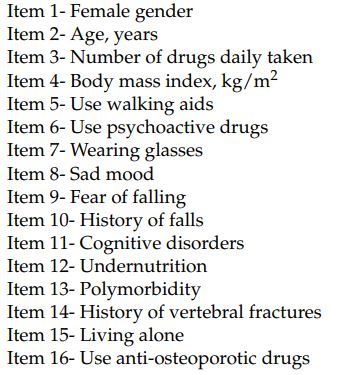Excellent prediction of very low vitamin D in elderly from just 16 questions (analyzed by ML)
Clinical Identification of Geriatric Patients with Hypovitaminosis D: The 'Vitamin D Status Predictor for Geriatrics' Study.
Nutrients. 2017 Jun 27;9(7). pii: E658. doi: 10.3390/nu9070658.
Annweiler C1,2, Riou J3,4, Alessandri A5, Gicquel D6, Henni S7, Féart C8, Kabeshova A9.
📄 Download the PDF from Vitamin D Life
The 16-item Vitamin D Status Predictor (VDSP) tool identifies healthy older community-dwellers at risk of hypovitaminosis D and may guide the use of blood tests in this population. The objective of the present hospital-based study was to test the efficacy of the VDSP to identify geriatric patients with hypovitaminosis D.
The study included 199 nonsupplemented geriatric in- and outpatients consecutively admitted to Angers University Hospital, France (mean ± SD, 82.0 ± 7.8 years; 53.3% female). Serum 25-hydroxyvitaminD (25(OH)D) was measured at the time of the physician-administered VDSP. Hypovitaminosis D was defined as serum 25(OH)D concentration ≤ 75 nmol/L for vitamin D insufficiency, 25(OH)D ≤ 50 nmol/L for vitamin D deficiency, and 25(OH)D ≤ 25 nmol/L for severe vitamin D deficiency. We found that 184 participants (92.4%) had vitamin D insufficiency, 136 (68.3%) had vitamin D deficiency, and 67 (33.7%) had severe vitamin D deficiency. The VDSP identified severe vitamin D deficiency with an area under curve (AUC) = 0.83 and OR = 24.0. The VDSP was able to identify vitamin D deficiency and vitamin D insufficiency with less accuracy (AUC = 0.71 and AUC = 0.73, respectively). In conclusion, the 16-item VDSP is a short questionnaire that accurately identifies geriatric patients with severe vitamin D deficiency. This tool may guide the use of blood collection for determining geriatric patients' vitamin D status.
Questions
Gender,
age (in years),
number of therapeutic classes used per day,
body mass index (BMI, in kg/m2),
use walking aids,
use psychoactive drugs (i.e., benzodiazepines, anti-depressants or neuroleptics),
wearing glasses,
sad mood,
fear of falling,
history of falls in the preceding year,
cognitive disorders,
Undernutrition,
Polymorbidity,
History of vertebral fractures,
living alone,
use anti-osteoporotic drugs (i.e., bisphosphonates, strontium, or calcium)

